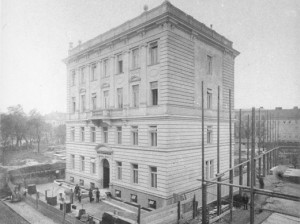
The historical building at Boltzmanngasse 3 dates back to the 1900s, years of exploration and innovation. In 1908 Vienna’s foremost patron of the sciences at the time, Karl Kupelwieser, initiated the Institute for Radium Research to further explore Marie Curie’s recent discovery of radium and its astounding properties by providing the Austrian Academy of Sciences with an amount of 500 Austrian crowns for its construction and furnishing. On 28 October 1910, the Institute for Radium Research was opened by Archduke Rainer of Austria.
Already in the first decade of its existence, Stefan Meyer’s first assistant Victor Franz Hess discovered the phenomenon of cosmic rays for which he in 1936 received the Nobel Prize in Physics. In the following years, the Institute’s researchers were conscripted to follow darker pursuits of inducing nuclear reactions. Several of the Institute‘s researchers were forced into exile by the Nazi regime 1938. After 1945, the focus shifted to nuclear reactions triggered by neutrons, and the relevant findings have found applications in medicine or for the construction of nuclear reactors. The Institute underwent several political and structural changes, turning into the Institute for Radium Research and Nuclear Physics, which in 1955 under Berta Karlik, the Institute’s director at the time who was appointed as the first female professor at the University of Vienna, was turned into a University Institute in addition to its Academy affiliation. It later was renamed again into Institute for Isotope Research and Nuclear Physics and ultimately in 2004 became the Stefan-Meyer-Institute for Subatomic Physics. In May 2015, the Boltzmanngasse 3 building was designated as an EPS Historic Site by the European Physical Society.
In November 2003, the Institute for Quantum Optics and Quantum Information (IQOQI) of the Austrian Academy of Sciences was founded with the objective to creating a place for theoretical and experimental quantum optics and quantum information research in Austria. Its Vienna branch, under the direction of Anton Zeilinger, joined the Stefan-Meyer-Institute at Boltzmanngasse 3. Today, IQOQI consists of nine research groups, headed by Markus Aspelmeyer (IQOQI’s director), Časlav Brukner (IQOQI's vice director), Peter Asenbaum, Esteban Castro Ruiz, Marios Christodoulou, Marcus Huber, Markus Müller, Miguel Navascues and Anton Zeilinger.

